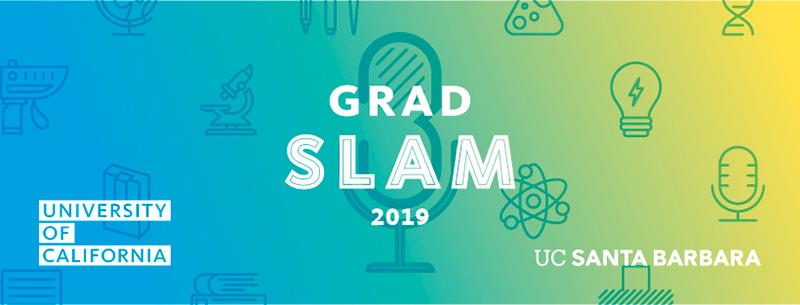Top Stories
After two weeks of competition, only 9 graduate students remain to compete in the final round of the 2019 Grad Slam this Friday. With thousands of dollars of prize money up for grabs, this is sure to be an event that you won't want to miss. If you can't make it in person, you can tune in to the livestream through UC Santa Barbara's Facebook page to catch all the excitement!

After two weeks of competition, only 9 graduate students remain âto compete in the final round of the 2019 Grad Slam this Friday. With thousands of dollars of prize money up for grabs, thisâ is sure to be an event that you won't want to miss. But don't worry, if you can't make it in person to support your friends and fellow grads, you can tune in to the livestream through UC Santa Barbara's Facebook page to catch all the excitement!
2019 Grad Slam Final Round
Friday, April 19
3 p.m.
Corwin Pavilion
Rebecca Baker | âEnglish
Science Fiction and the Power of Possible Worlds
Although often denigrated as "lowbrow", science fiction--at its best--is a powerful tool for defamiliarizing, analyzing, and intervening into our complex technocultural, often dystopic realities. Sci-fi creatively reflects and reimagines how biology, technology, and culture are entangled in rich and polyvalent ways, compelling us to engage with new attention to situations and problems that are too often given up as "inevitable". This talk focuses on how sci-fi might begin to productively bridge the communication gap between the arts and sciences, opening new modes of discourse through its ever-contingent preoccupation with alienation, alterity, and the power of possible worlds.
Vinnie Wu | Psychological & Brain Sciences
Motivation Matters: Are Positive Intergroup Interactions Positive for Everyone?
With increasing racial diversity and geographic mobility, intergroup interactions are inevitable, often resulting in conflict. Previous research establishes the effectiveness of positive intergroup interactions in reducing prejudice. In this talk, I propose that this effectiveness differs depending on individuals' motivational orientation, distinguishing between approach- and avoidance-oriented individuals.
Taylor Heisley-Cook | Environmental Science & Management
âWaste to Wear: Fabric from Cannabis Waste
The biggest impact of any given garment comes from raw material production. MMC fabrics (better known as viscose, rayon, tencel, or modal) are made from wood pulp, which is often unsustainably harvested from Indonesian old-growth forests. I am developing a technique to convert cannabis waste -- millions of tons of which is currently being burned or sent to landfill each year -- into MMC feedstock pulp.
Ana Sofia Guerra | Ecology, Evolution & Marine Biology
Cloudy with a Chance of Bird Poop: A Tale of Seabirds and Nutrients
Wildlife can completely transform the habitats they inhabit. Seabirds, in particular, can transform ecosystems through nutrient excretion - they continuously deposit nutrient rich feces (guano) onto terrestrial and marine environments. The Channel Islands, off the coast of Central California, support some of the largest colonies of Western Gulls, a local seabird. I am exploring the amount of guanoâ "raining" down on the islands and the impact rain of guano might have on these ecosystems.
Camille Endacott | Communication
When Artificial Intelligence Makes Your Day
Organizational leaders have entrusted assistants to manage their schedules for some time, but advances in artificial intelligence present new possibilities for how decisions about managerial time are made. Though outsourcing decisions about one's schedule to humans or artificial intelligence may seem innocuous, these choices have important implications for how managerial attention is directed in organizations. This presentation compares decisions made by human and artificial intelligence related to managers' time and attention and discusses the consequences for organizations and society.
Zachary Reitz | Chemistry
Chained by Iron: The Tug-of-War Between Bacteria and Our Body
Bacteria need iron to grow, just like we do. Many of them get it by making siderophores, which are molecules that grab iron and hold it tightly. Pathogens can even use siderophores to rip iron out of our blood. By studying the genomes of bacteria, we can learn how these molecules are made.
Phoebe Racine | âEnvironmental Science & Management
Planning for the Next Food Revolution
The Southern California Bight is a highly productive ecosystem, raising interest in its potential to support aquaculture operations, especially mussel farming. With a swell of applications in the permitting pipeline, California has the chance to develop an offshore aquaculture industry. However, there is concern that too much farming could lead to a reduction in Net Primary Productivity (NPP). In this presentation, I'll introduce scenarios that explore ecological thresholds of futuristic mussel farming.
Melissa Gordon Wolf | Education
âOn a Scale of One to Ten
Self-report surveys are ubiquitous in our personal lives and research, and the results can have high stakes consequences. Yet, we've all encountered moments where we've thought to ourselves: "none of these response options apply to me" or "what does this item mean?". Insofar as these moments occur, the validity of a survey's uses and interpretations is threatened. This presentation will introduce a new, evidence-based method for constructing, testing, and validating self-report survey items.
George Degen | âChemical Engineering
Healing Muscles with Mussels
The human body and the ocean have a lot in common: both are wet and salty, making them challenging environments for adhesive glues. Nevertheless, marine mussels produce glues that stick to almost any surface under water. My goal is to learn from marine mussels and engineer a glue that sticks to muscle tissue in the body-a mussel-inspired medical adhesive!